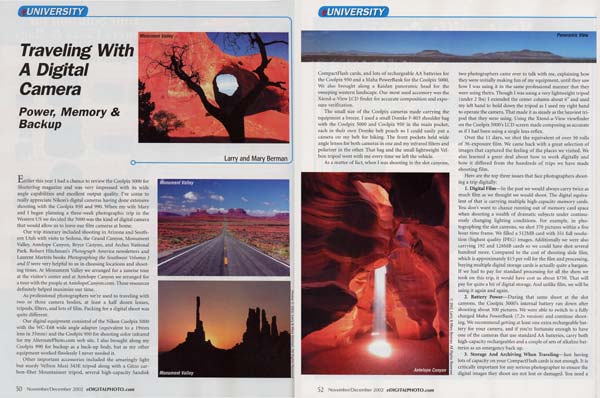Earlier this year I had a chance to
review
the CoolPix 5000 for Shutterbug Magazine and was very impressed with its
wide-angle capabilities and excellent output quality. I’ve come to really
appreciate Nikon’s digital cameras having done extensive shooting with the Coolpix 950 and 990. When my wife Mary and I began planning a three-week
photographic trip in the Western United States we decided the 5000 was the
kind of digital camera that would allow us to leave our film cameras at
home.
Our trip itinerary included shooting in Arizona and
Southern Utah with visits to Sedona, the Grand Canyon, Monument Valley,
Antelope Canyon, Bryce Canyon and Arches National Park. Robert Hitchman’s
“Photograph America” newsletters and Laurent Martrès books “Photographing
the Southwest volumes I and II” were very helpful to us in choosing
locations and shooting times. At Monument Valley we arranged for a sunrise
tour at the visitors center and at Antelope Canyon we arranged for a tour
with the people at AntelopeCanyon.com. These resources definitely helped
maximize our time.
As professional photographers we’re used to traveling
with two or three camera bodies, at least a half dozen lenses, tripods,
filters and lots of film. Packing for a digital shoot was quite different.
Our digital equipment consisted of the Nikon CoolPix
5000 with the WC-E68 wide angle adapter (equivalent to a 19mm lens in
35mm) and the CoolPix 950 for shooting color infrared for my
AlternatePhoto.com web site. I also brought along my CoolPix 990 for
backup as a backup body, but as my other equipment worked flawlessly I
never needed it.
Other important accessories included the amazingly light
but sturdy Velbon Maxi 343E tripod along with a Gitzo carbon fiber
Mountaineer tripod, several high capacity Sandisk compact flash cards, and
lots of rechargeable AA batteries for the Coolpix 950 and a Maha Powerbank
for the CoolPix 5000. We also brought along a Kaidan panoramic head for
the sweeping western landscape. Our most used accessory was the Xtend-a-View
LCD finder for accurate composition and exposure verification.
The small size of the CoolPix cameras made carrying the
equipment a breeze. I used a small Domke F-803 shoulder bag with the
CoolPix 5000 and CoolPix 950 in the main pocket, each in their own Domke
belt pouch so I could easily put a camera on my belt for hiking. The front
pockets held wide angle lenses for both cameras in one and my infrared
filters and polarizer in the other. That bag and the small light weight
Velbon tripod went with me every time we left the vehicle.
As a matter of fact, when I was shooting in the slot
canyons, two photographers came over to talk with me, explaining how they
were initially making fun of my equipment, until they saw how I was using
it in the same professional manner that they were using theirs. Though I
was using a very lightweight tripod (under two pounds) I extended the
center column about six inches and used my left hand to hold down the
tripod as I used my right hand to operate the camera. That made it as
steady as the heaviest tripod that they were using. Using the Xtend-a-View
viewfinder on the CoolPix 5000’s LCD screen made composing as accurate as
if I had been using a single lens reflex.
Over the 11 days, we shot the equivalent of over 50
rolls of 36-exposure film. We came back with a great selection of images
that captured the feeling of the places we visited. We also learned a
great deal about how to work digitally and how it differed from the
hundreds of trips we have made shooting film.



